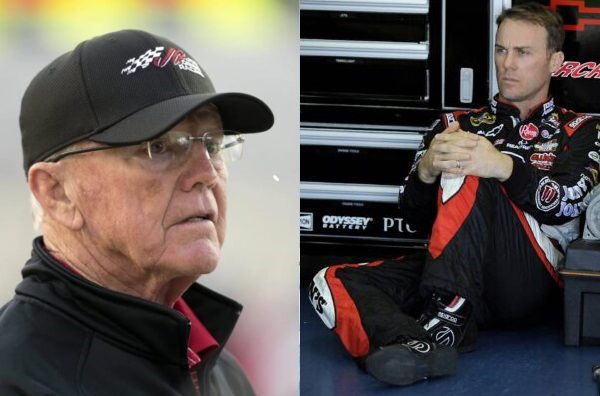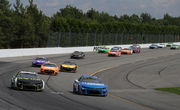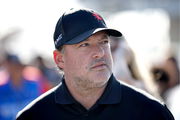

High stakes and even higher tension marked an afternoon of racing at New Smyrna Speedway as the World Series of Asphalt Super Late Model opener delivered a shock to reverberate throughout the racing community. A racing star on the rise, William Sawalich is affiliated with not only Joe Gibbs Racing but also Kevin Harvick Inc. But it’s all not a smooth ride for the young rising star.
Sawalich was left heartbroken last weekend when his car was disqualified after a post-race inspection. The disqualification stemmed from a technical infraction on the front-end tread width. Veteran technical inspector Rick Turner, who has spent more than 45 years behind the wheel and in the pits, finally spoke out about the matter at hand.
ADVERTISEMENT
Article continues below this ad
Rick Turner puts weight behind Sawalich’s disqualification
For Sawalich—a driver often touted as a prodigy with the promise of future championships—the incident represents more than just a technical setback. It is a harsh reminder that in motorsports, pure talent cannot define winning. The technical precision required at this level can make or break a career, and even slight deviations from regulation can result in lost points, lost opportunities, and, in this case, heartbreak for the team with him.
Turner’s frustration was palpable as he recalled the steps taken to give Sawalich’s team every opportunity to remedy the infraction. “We ran it back through like a pre-tech deal like it was pre-qualifying tech and it was still too wide,” Turner continued. “We gave him the opportunity to make it right by going through a pre-tech session and he failed it both times. As a racer for 45 years, this is one thing I don’t like about what I’m doing. I know what kind of money it takes to do this deal, I know the time it takes, and I really feel for them. But I have to uphold the rule too, and that’s why they hired me,” Turner concluded.
Rick Turner, known for his no-nonsense approach and deep understanding of the sport, explained the situation in candid detail. “Usually after every race, we check the track width on the front end,” he stated. “I know from my own experience racing Late Models that my car will get wider up north, and I know some of the guys do it down here and some of them don’t. I have a habit of checking them. This is the first one I’ve found that actually went wide and stayed wide.”

What’s your perspective on:
Is strict adherence to technical rules stifling the innovation and talent of young racers like Sawalich?
Have an interesting take?
While the tread width limit is set at 66 inches, most drivers aren’t too worried about going beyond because the width gets shorter after the race because of high wear. However, in Sawalich’s case, things were different. Even after the race, the tread width, meaning the width of the tire comes in contact with the asphalt was greater than the set limit. It put an entirely new perspective on the late drama in the race, where Sawalich managed to hold off in the final five laps.
Late-model racing calls for a significant balance between innovation and regulation; on one side, drivers and teams are consistently pushing the limit of engineering and setup adjustments just to gain a competitive edge. On the other hand, governing bodies of the sport need to adhere to very strict technical standards to ensure and maintain a level playing field, something seen in Connor Jones’ case.
Trending
ADVERTISEMENT
Article continues below this ad
Conner Jones denied a win despite finishing first
In a surprising turn of events, Conner Jones was classified as the Pro Late Model race winner only to have his checkered flag taken away after not passing post-race technical inspection. The controversy? A carburetor that did not comply with class requirements, and for which the drivers and fans can’t stop discussing. Jones’ team had installed a carburetor that is NASCAR-approved for Late Model Stocks.
Notably, this particular unit is safety-wired with epoxy, a measure designed to prevent pucks from falling and inadvertently “hanging” the motor wide open. According to insiders, the same carburetor has been used in previous races at New Smyrna with consistent success. However, in the ASA Super/Pro Late Model regulations for this race, the carburetor does not meet the criteria for approval. Essentially, although it complies with the requirements of NASCAR for Late Model Stocks, it is not compliant with the higher technical standards established for Pro Late Models.
Jones’ team is not taking the decision lying down. They are seriously pursuing the appeal mechanism, citing that the carburetor is identical to the one that won races in the past at New Smyrna. Their case hinges on a critical question: if a component has proven its reliability and safety in previous races, should it be penalized simply because it was designed to meet a different set of rules?
ADVERTISEMENT
Article continues below this ad
In this case, Jones’ team is scrutinizing whether a grandfather clause might apply or if there is any leeway provided in the rule book for components that have a history of safe and competitive performance. Fans will be watching closely as the appeal process unfolds, hoping that clarity—and perhaps a bit of leniency—will emerge from this technical impasse.
ADVERTISEMENT
ADVERTISEMENT
ADVERTISEMENT
ADVERTISEMENT







Is strict adherence to technical rules stifling the innovation and talent of young racers like Sawalich?